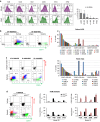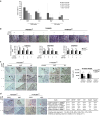CD57 defines a novel cancer stem cell that drive invasion of diffuse pediatric-type high grade gliomas
- PMID: 38834745
- PMCID: PMC11263392
- DOI: 10.1038/s41416-024-02724-5
CD57 defines a novel cancer stem cell that drive invasion of diffuse pediatric-type high grade gliomas
Abstract
Background: Diffuse invasion remains a primary cause of treatment failure in pediatric high-grade glioma (pHGG). Identifying cellular driver(s) of pHGG invasion is needed for anti-invasion therapies.
Methods: Ten highly invasive patient-derived orthotopic xenograft (PDOX) models of pHGG were subjected to isolation of matching pairs of invasive (HGGINV) and tumor core (HGGTC) cells.
Results: pHGGINV cells were intrinsically more invasive than their matching pHGGTC cells. CSC profiling revealed co-positivity of CD133 and CD57 and identified CD57+CD133- cells as the most abundant CSCs in the invasive front. In addition to discovering a new order of self-renewal capacities, i.e., CD57+CD133- > CD57+CD133+ > CD57-CD133+ > CD57-CD133- cells, we showed that CSC hierarchy was impacted by their spatial locations, and the highest self-renewal capacities were found in CD57+CD133- cells in the HGGINV front (HGGINV/CD57+CD133- cells) mediated by NANOG and SHH over-expression. Direct implantation of CD57+ (CD57+/CD133- and CD57+/CD133+) cells into mouse brains reconstituted diffusely invasion, while depleting CD57+ cells (i.e., CD57-CD133+) abrogated pHGG invasion.
Conclusion: We revealed significantly increased invasive capacities in HGGINV cells, confirmed CD57 as a novel glioma stem cell marker, identified CD57+CD133- and CD57+CD133+ cells as a new cellular driver of pHGG invasion and suggested a new dual-mode hierarchy of HGG stem cells.
© 2024. The Author(s), under exclusive licence to Springer Nature Limited.
Conflict of interest statement
The authors declare no competing interests.
Figures







Similar articles
-
The prognostic value of clinical factors and cancer stem cell-related markers in gliomas.Dan Med J. 2014 Oct;61(10):B4944. Dan Med J. 2014. PMID: 25283629
-
Silencing BMI1 eliminates tumor formation of pediatric glioma CD133+ cells not by affecting known targets but by down-regulating a novel set of core genes.Acta Neuropathol Commun. 2014 Dec 20;2:160. doi: 10.1186/s40478-014-0160-4. Acta Neuropathol Commun. 2014. PMID: 25526772 Free PMC article.
-
Patient-derived glioblastoma stem cells are killed by CD133-specific CAR T cells but induce the T cell aging marker CD57.Oncotarget. 2015 Jan 1;6(1):171-84. doi: 10.18632/oncotarget.2767. Oncotarget. 2015. PMID: 25426558 Free PMC article.
-
Hemispherical Pediatric High-Grade Glioma: Molecular Basis and Therapeutic Opportunities.Int J Mol Sci. 2020 Dec 17;21(24):9654. doi: 10.3390/ijms21249654. Int J Mol Sci. 2020. PMID: 33348922 Free PMC article. Review.
-
What is the clinical value of cancer stem cell markers in gliomas?Int J Clin Exp Pathol. 2013;6(3):334-48. Epub 2013 Feb 15. Int J Clin Exp Pathol. 2013. PMID: 23412423 Free PMC article. Review.
References
-
- Baxter PA, Su JM, Onar-Thomas A, Billups CA, Li XN, Poussaint TY, et al. A phase I/II study of veliparib (ABT-888) with radiation and temozolomide in newly diagnosed diffuse pontine glioma: a Pediatric Brain Tumor Consortium study. Neuro Oncol. 2020;22:875–85. 10.1093/neuonc/noaa016 - DOI - PMC - PubMed
-
- Stupp R, Hegi ME, Mason WP, van den Bent MJ, Taphoorn MJ, Janzer RC, et al. Effects of radiotherapy with concomitant and adjuvant temozolomide versus radiotherapy alone on survival in glioblastoma in a randomised phase III study: 5-year analysis of the EORTC-NCIC trial. Lancet Oncol. 2009;10:459–66. 10.1016/S1470-2045(09)70025-7 - DOI - PubMed
MeSH terms
Substances
Grants and funding
- R01 CA185402/CA/NCI NIH HHS/United States
- 32100563/National Natural Science Foundation of China (National Science Foundation of China)
- CA185402/U.S. Department of Health & Human Services | NIH | Center for Information Technology (Center for Information Technology, National Institutes of Health)
- 8217112078/National Natural Science Foundation of China (National Science Foundation of China)
LinkOut - more resources
Full Text Sources
Medical
Research Materials

